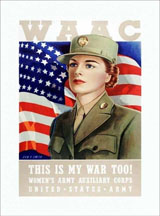Our lexicographer considers words
and phrases that developed as
the United States
was engaged in
World War II
World War II enriched our vocabulary in numerous venues—the service branches, overseas combat, and weapons. Here let us consider some expressions associated with the home front, a term actually coined shortly after World War I. That expression is also used more broadly now, as by J. P. O’Donnell in his 2009 novel Deadly Codes, where one character querying another about the state of his marriage, asks, “How are things on the home front?”
A similar expression used principally by U.S. service personnel stationed abroad is stateside, meaning of, in, or to the United States. Although this term had been used earlier in Hawaii and the Philippines, it only became widespread during World War II.
Before World War II, the only women employed in the ranks of the U.S. Army were nurses. Early in 1941, Congresswoman Edith Nourse Rogers met with Gen. George C. Marshall about introducing a bill to set up a women’s branch of the U.S. Army. He asked her to delay, but with his support (and Pearl Harbor), a bill in May 1942 established the Women’s Army Auxiliary Corps, or WAAC. Later the acronym was changed to WAC (Women’s Army Corps), and in 1948, Congress approved regular and reserve status for women in all branches of the service. Ultimately more than 150,000 women served as WACs during World War II, both at home and overseas.
WAVES was its counterpart in the navy, the name an acronym for Women Accepted for Volunteer Emergency Service. Established just two months after the WAAC, it differed in that it was not an auxiliary, like the WAAC, but was a regular branch of the navy. In addition, its members served only within the United States. The coast guard had the SPARS, named for the coast guard motto “Semper Paratus” (Always Ready); the air force the WAFS, Women Auxiliary Ferrying Squadron, who ferried aircraft until being disbanded in 1944; and the Marine Corps Women’s Reserve took over clerical and other duties to free men for more-active service. In 1948 with passage of the Women’s Armed Services Integration Act, these organizations officially ceased to exist because women now could simply enlist in the navy, air force, army, and marine corps, but WAC continued to be used for at least three more decades.
Numerous other quasi civilians contributed to the war effort. Particularly important were the backroom boys, a name given by William Maxwell Aitken, Britain’s Lord Beaverbrook, to the scientists and technicians who contributed to developing scientific warfare and aiding war production. After the war, the expression continued to be used for any unnamed or unsung heroes whose work enabled technological and scientific advances.
War production was a round-the-clock enterprise, factories going day and night. It gave rise to renewed use of the term graveyard shift, originating in World War I but used largely during World War II. Applied to any factory shift covering the midnight and early morning hours, it continued to be used after the war for civilian operations working around the clock. The graveyard shift was preceded by the swing shift, the working hours from 3 p.m. to midnight. Both were extremely important to the war effort.
Shortages, rising food prices, and point rationing impelled many civilians to plant vegetable gardens, called Victory gardens. Your columnist’s New York City elementary school dug up part of its cement yard to plant vegetables, both for immediate eating and for canning. In 1943, Americans planted more than 20 million Victory gardens, and the harvest accounted for about one-third of all the vegetables consumed in America that year.
A wartime shortage of housing and materials for new construction was partially alleviated by the Quonset hut, a semicylindrical, prefabricated building of corrugated metal that was used for barracks, garages, schools, and storage. Developed by the navy at Quonset Point, Rhode Island, the first such huts were sent to England in June 1941 under Lend-Lease. By the end of 1942, some 34,000 had been constructed. The huts, although allegedly temporary, proved to be quite durable and continued to be used after the war as dormitories and to store supplies at construction and other sites.
Shortages and rationing also gave rise to the less-than-admirable practice of under-the-counter sales. Dishonest merchants kept certain goods in short supply, sometimes literally hiding them under the counter to sell to favored customers or, more often, at exorbitant prices. This illegal practice, also called the black market, was first referred to in Europe in 1939 but soon spread to the United States and proliferated throughout the war. Both terms continue to be used. MHQ






